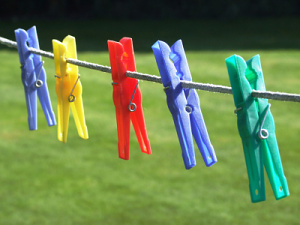Washing in winter: ideas for reducing laundry?
 Hi guys, sorry for the radio silence for the last few days – I went on a drama training course on Tuesday and have only just recovered ;) It was a lot of fun and very useful but I’m farrrrr too lazy for what was essentially a five hour exercise class. My neck is sore and I’ve a huge bruise on my knee from stage combat training but on the other hand, pretending to beat up a new colleague for 2.5hrs is a really good bonding experience :)
Hi guys, sorry for the radio silence for the last few days – I went on a drama training course on Tuesday and have only just recovered ;) It was a lot of fun and very useful but I’m farrrrr too lazy for what was essentially a five hour exercise class. My neck is sore and I’ve a huge bruise on my knee from stage combat training but on the other hand, pretending to beat up a new colleague for 2.5hrs is a really good bonding experience :)
ANYWAY, back to reality now. Lazy, lazy reality. I do like being lazy in winter because it can actually be an efficient/frugal way to do things: yesterday, John was out of the house all day so me & my aching body worked from bed until I had to go to out myself – no need for heating. And as I’ve said before when talking about linedrying laundry in winter, some things just get left until spring: throws/blankets get taken out of service, occasional wear that I won’t need for another few months can stay in the washing basket, and bedding etc gets left in the washing basket too until a nice drying-outside day, even if that’s another month (or longer) away. Lazy is good.
But I wondered what other strategies people use for reducing the amount of laundry they have to get through in winter. Aside from burst washing machine pipe incidents, the washing isn’t the hard part but the line drying is, particularly if you’re tight on space at home.
I remember looking into the issue of laundry a year or so ago and being shocked how much people wash clothes – a whole outfit in the wash every day – some people wash bedsheets & tumble dry every day. I mean, gosh! Around here, underwear gets changed every day, t-shirts every other day, jeans & jumpers not so much. They get washed when they’re dirty, which isn’t after one day for us desk jockeys. I also have different sets of clothes for different jobs – for example, my scruffs (for gardening/chicken coop cleaning/DIY) have a much higher dirtiness threshold than the nicer clothes I wear when I’m teaching.
How about you? Do you try to minimise the amount of washing you do in the winter (or all year around)? If so, what tactics do you use? If you don’t – how do you keep on top of it all in the cold days of winter?
Read MoreHow I line dry clothes in winter: my top five tips
Line drying clothes outside has been a near impossibility this winter – but aside from a load of bedding (including a duvet) that got vomited on (thanks Lily-dog), I’ve line dried everything else inside.
Here’s some of the tricks I’ve used:
1) Get lazier – leave stuff to wash later when the weather is better
 Aside from when there have been sick dog incidents, I leave stuff like towels & bedding in the washing basket until they really need doing because our stash of spare clean ones are running low – or until it looks like it’ll be a nice enough day to dry a load outside. Our bedding really needs to line dry outside to blow out the animal fluff.
Aside from when there have been sick dog incidents, I leave stuff like towels & bedding in the washing basket until they really need doing because our stash of spare clean ones are running low – or until it looks like it’ll be a nice enough day to dry a load outside. Our bedding really needs to line dry outside to blow out the animal fluff.
If heavy things like throws and cushions/pillows get dirty, they just get taken out of use until it looks like there will be a run of decent drying days (even if that means waiting until spring).
If I can’t see myself wearing an item of clothing until much later in the year – some piece of occasional wear like a nice dress or skirt – then they won’t get washed until later in the year either.
I’ll catch up washing everything eventually but in the meantime, it means there isn’t as much congestion for my limited airer space.
2) Get more organised
That congestion on the airer is my main problem so I make sure I wash loads regularly, without too much needing doing at once.
If I do get a backlog – for example when I was ill at the start of the year or when our washing machines pipes froze (then unfroze all over the kitchen), I separate by both colour (light/dark) and by weight of fabric – all coloured t-shirts etc in the first load, then heavier stuff such as jeans & hoodies in the next. The t-shirts will be dry in a day or so, emptying the whole airer for the heavier stuff, which takes three days or so to dry – rather than two mixed loads which would both take a 3+ days to dry. (Another reason to batch wash’n’dry towels rather than doing some in each load.)
Socks & underwear etc are used to fill up space whenever there is a bit of empty space. They get dried on the peg airer thing (see below).
My top 5 clothes line drying tips
 Environmental blogger The Crunchy Chicken is having a line drying challenge for readers of her blog next month – getting people to give up their default use of clothes dryers and make them think about greener alternatives instead.
Environmental blogger The Crunchy Chicken is having a line drying challenge for readers of her blog next month – getting people to give up their default use of clothes dryers and make them think about greener alternatives instead.
From both the green and frugal perspectives, I fully support the idea but think it’s a strange time of year to have the challenge – if the purpose is to convert new people to line drying, then now, when it’s getting colder and damper, is not the time to do it. It’s a hard time to line dry. But I guess that is part of Crunchy’s challenge – anyone can line dry in summer, it’s easy to convert people to line drying in summer but if you can show people how line drying is possible all year around, it’ll be more sustainable – not just fair-weather converts.
Here are my top five clothes line drying tips:
1. Find the clothes drying rack/airer that’s right for your home & garden
This feels like a bit of an obvious point but there is a lot of variety. Think about what you’ll use it for most and how you’ll use it rather than buying the first one you see.
Our last house was very short on floor space so we had a ceiling-mounted rack that could be raised or lowered. Here, we’ve got more space but only heat the rooms we’re in so an easily portable airer is better (those vertical concertina style ones fold up and can be carried even when stack with clothes). Radiator ones can be a useful, neat overflow but be careful not to use them for bulky items – it reduces the air flow too much for the middle rows to dry.
Outside, rotary ones give a lot of hanging space and can be folded away easily and quickly. However, they’re awkward to use for bedsheets and other big items – a basic line is better for those (you can get retractable lines too, so they can be folded away easily as well).
And if you live in an area which is frequently showery, you’d be best thinking of an outdoor line you can cover so you can make the most of the warm sunny bits in between the rain — rotary driers can be covered or you can buy ones that are essentially an airer in a tent.
Read More



